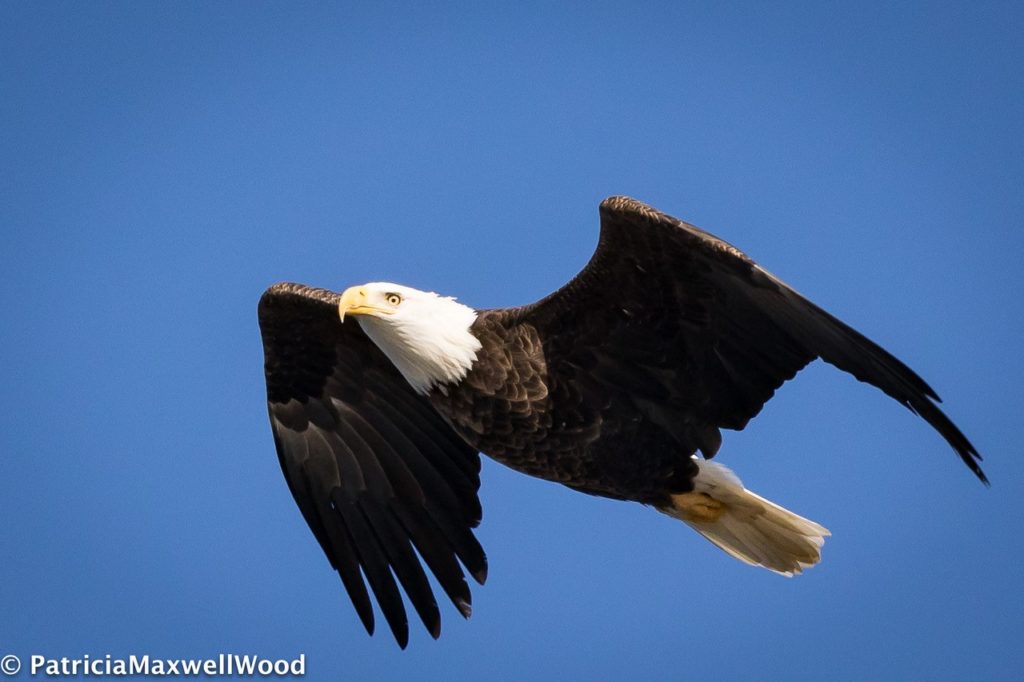
At the very last minute, Susan Yurkus and I replaced Dave Weaver and Dave Larson as leaders, giving everyone quite a surprise for this week’s Wednesday Morning Birding. We took our group of about a dozen birders on the icy roads to the north end of Plum Island in sunny weather, at about 32 degrees with a rising wind from the northwest. Right as we arrived, a beautiful adult Bald Eagle flew over us, a good omen for the upcoming Merrimack River Eagle Festival. Today it was challenging to see birds across the river. A very large raft of Common Eiders flew and foraged over mussel beds under the river waters of the opposite bank. One of those eiders had a black body and light-colored head, but we couldn’t see the marks that would positively identify an adult drake King Eider, which was seen there last Saturday. Common Goldeneyes, Red-breasted Mergansers, White-winged Scoters, and Long-tailed Ducks all joined in.
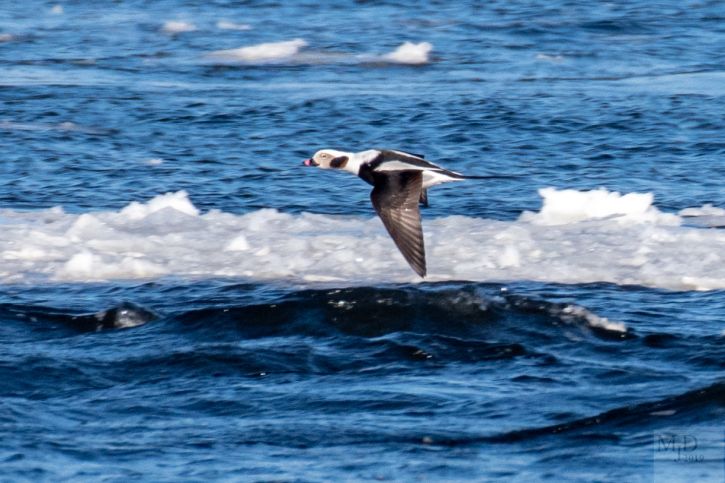
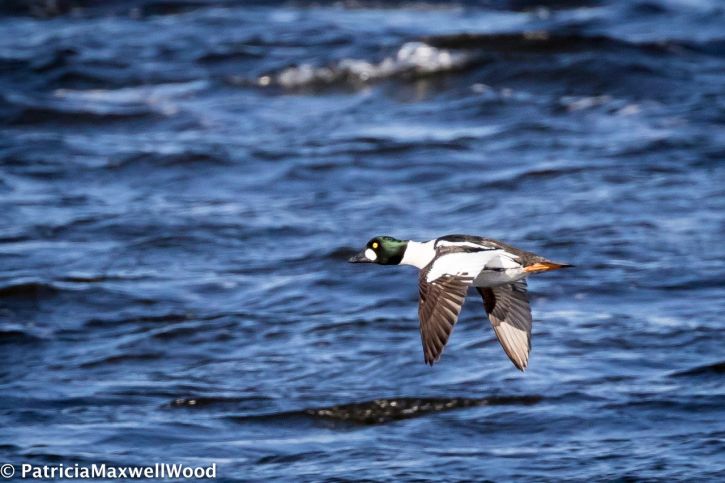
The neighborhoods were quiet, so our next birds of note came with three Northern Harriers busy in the marsh near the Parker River National Wildlife Refuge gatehouse.

From the parking lot #1 stairway, we found a smooth ocean with big, beautiful breakers. They produced a sparkling spume under a wind that was hurrying our relatively mild air out to sea in advance of the arrival of the polar vortex. The first thing to catch our eyes was a raft of Long-tailed Ducks not too far offshore. Eventually we found a pair of Horned Grebes with them, and then rafts of Black and White-winged Scoters here and there among kleptoparasitic Herring Gulls. As we prepared to leave the platform, I suggested that people scan the dunes to the south for a Snowy Owl, and David Godwin, a birder new to WMB, quickly spotted what looked like a Snowy out in the marsh. When we drove down along the road to be closer to this bird, everyone agreed that it was suspiciously the whitest Snowy Owl we had ever seen. Several of us had the same thought when we first looked at it: “Not another lump of snow…” But then the lump of snow turned its head. Nice work, David G.!

As we drove further south, a dark raptor came into view, working its way north above the edge of the maritime forest. I pulled over to see it and hopped right out. The large size and dark color had me expecting a Rough-legged Hawk from a distance. Last Saturday, in a program I was leading near the same spot, we had seen two Rough-legged Hawks, one a light phase and the other a dark phase, so I was teaching people about color morphs, saying how Rough-legged Hawks always have light-colored secondaries and inner primaries. So when this very dark, large bird flew into view, I noticed and remarked that this was the darkest Rough-leg I had ever seen, which was so charming after having witnessed the whitest Snowy we’d ever seen. What a perfectly coincidental experience for everyone!
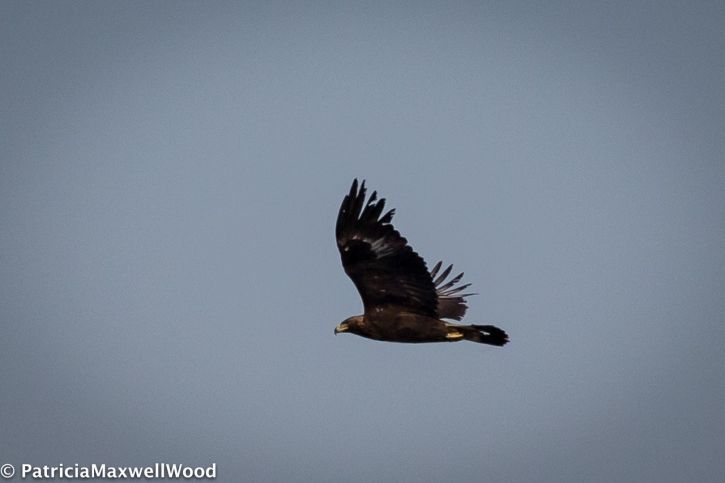
However – as soon as I looked at our photos, I discovered that my brain was playing a trick on me. That large, dark bird actually wasn’t a hawk at all; all I had to do was look at the giant bill on that thing. It was a Golden Eagle! Tom Wetmore says “That’s a super rare bird on the refuge; I’ve never had a convincing sighting in my 37 years out there.” We should have been jumping up and down with glee, but we weren’t. For the first few hours after I realized my mistake, I was so mortified that I told all my buddies and my new wife that I was moving to Australia immediately. I’ve just passed the 3-year mark here at Joppa Flats, and I love it dearly, but I would have been very happy to be instantly transformed into a macroinvertebrate under some rock on the other side of the globe. As that beautiful bird disappeared, David Godwin was at it again! He spotted a tiny, white bird-speck high above the marsh that turned out to be the highest Snowy Owl we ever saw out there, but as you can see below, this bird has plenty of dark flecking to show its a different Snowy Owl.

Every one of us was blissful in our ignorance of the eagle that day, so we merrily drove past the gate at Hellcat (which we thought would be closed) and arrived at parking lot #7, happy to be there for the first time in a while. The seascape there was impressive with the big waves breaking on the shoals at the mouth of Ipswich Bay. Emerson Rocks was exposed, surrounded by eiders, scoters, goldeneyes, and Buffleheads. At least three pairs of Horned Grebes were out there, but the King Eider spending this winter there didn’t come out until after we’d left; it was seen by another birder we heard from later. Safe from the wind, tucked behind dunes, we enjoyed the scene until it was time to try Hellcat.
Hellcat was a wonderful bust. It was one of those times you go up on the dike to be assaulted by the wind, but you struggle out to the tower anyway, and you endure, and then you turn back. The empty-handed hard work of that experience will be made up for by some evening in summer when the place will be mobbed with shorebirds, egrets, and a horde of Tree Swallows. Rolling back past North Field, we were treated to an uncommon sight — an adult male Northern Harrier, which lilted away toward The Wardens. Finally, at the Main Panne, there was a little crowd of birders, so we stopped to find our pure-white Snowy Owl again, this time doing a perfect imitation of marsh ice. What a day on Plum Island!
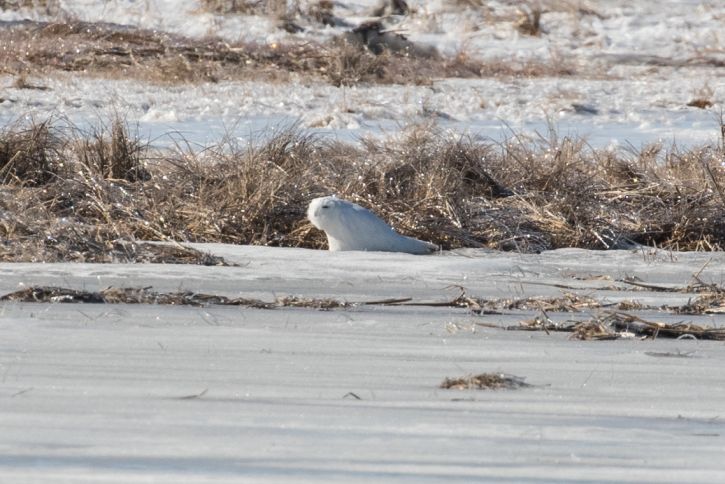
Our List:
Canada Goose – common; salt marsh.
American Black Duck – common; salt marsh.
Common Eider – common; north end and Emerson Rocks.
White-winged Scoter – common.
Black Scoter – common.
Long-tailed Duck – common.
Bufflehead (40) – Emerson Rocks.
Common Goldeneye – common; north end, Emerson Rocks, Bar Head.
Red-breasted Merganser (8) – various.
Horned Grebe (8) – 2 one ocean, 6 Emerson Rocks.
Rock Pigeon – common; developed areas.
Mourning Dove (1)
Ring-billed Gull (8) various.
Herring Gull – common
Great Black-backed Gull (4) various.
Common Loon (1) – Emerson Rocks.
Bald Eagle (1) – north end.
GOLDEN EAGLE (1) – near Main Panne.
Northern Harrier (~6) – various, including one adult male at North Field.
Red-tailed Hawk (2) – 1 imm. at North Field, 1 on PI Turnpike – off island.
Rough-legged Hawk (1) Cross Farm Hill.
Snowy Owl (2) – 1, on North Marsh and Maine Panne, 1 flying over North Marsh. One of these birds was pure white, the other noticeably flecked.
American Crow (1) – S-Curves.
Black-capped Chickadee (1) – roadside.
American Robin (1) – Pines Field.
Northern Mockingbird (1) – near seven.
European Starling – common; developed areas.
Song Sparrow (2) – Hellcat.

